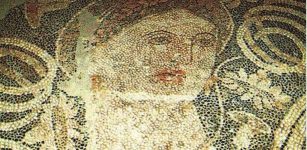Sayyida Al Hurra – Feared And Respected Pirate Queen Of Morocco Had No-One To Turn At The End
Ellen Lloyd - AncientPages.com - In 1492, the Catholic Monarchs Isabella I of Castile and Ferdinand II of Aragon succeeded in taking control of the Iberian Peninsula, and capture Grenada.
Those who refused to convert to Christianity were forced to flee. Among the refugees from Grenada was a little girl named Sayyida who took sought refuge with her parents and relatives in Morocco.
Portrait of Sayyida Al-Hurra. Credit: Public Domain
Sayyida was only 2 years old when she found a new home in a foreign country. Being a family member of Banu Rashid, a powerful and wealthy tribe she could enjoy a happy and secure childhood. Yet, Sayyida could never forget and forgive the humiliation of being forced to leave Grenada. When she grew up, she became a fierce enemy of the Christians and she sought revenge on the Spaniards.
Who Was Sayyida Al Hurra?
Her real name has been lost to history, but she is today known as Sayyida al-Hurra, which means “noble lady who is free and independent; the woman sovereign who bows to no superior authority”. At the age of 16, Sayyida al-Hurra (1485 – 1561) married Ali al-Mandri, a much older man who was also a refugee from Andalusia. Her husband, who was a friend of her father was a governor of the city of Tétouan in northern Morocco. It should be added that some sources state she married his son.
Regardless of which one she married, it is known that Sayyida who was an intelligent woman advised her husband, assisted him in his business affairs, and became involved in politics.
Through her participation in many important meetings, Sayyida met many powerful people who later played a significant role in her life. One of them was the sultan of Morocco, Abu al-Abbas-Amhad ibn Muhammad of the Wattasid dynasty who gave her permission to rebuild the city of Tétouan that had been destroyed by the Castilians around 1400.
After her husband died, Sayyida al-Hurra succeeded as governor of Tétouan, and declared herself the sole ruler of the city. According to Hasna Lebbady, author of Feminist Traditions in Andalusi-Moroccan Oral Narratives, “she knew what needed to be done under different circumstances and these are the kinds of qualities that would have made her a leader.”
Sayyida Al-Hurra Begins An Adventurous Life As A Pirate
“During Sayyida’s time, women under sharia law had more freedom than women under many Western legal systems. For example, traditional interpretations of sharia law said that Islamic women could divorce, keep their surnames after marriage, and handle their own financial affairs,” Laura Sook Duncombe writes in her book Pirate Women.
In 1541, Sayyida married Ahmed al-Wattasi, a Sultan of the Moroccan Wattasid dynasty. This was the beginning of a new chapter in her life. She could have lived a comfortable life and enjoy political success, but she wanted more. Memories from the past haunted her and she could not forget what the Spaniards had done to her family. She could not let go of Grenada and the fact she was forced to leave.
Though she had only been a small child at the time, historians think much of her hatred came from overhearing adults’ discussions during her childhood. Many exiles kept talking about taking revenge on the Spaniards and her head was filled with ideas on how to fight the Christian invaders, as they were seen through her eyes. In her wish to avenge herself on the "Christian enemy", she turned to piracy and contacted the famous Ottoman pirate Barbarossa of Algiers.
When Barbarossa (1475 – 1536) met Sayyida al-Hurra he was first amused. His attitude changed quickly as he realized this was an extraordinary woman one must respect. Sayyida al-Hurra led several successful pirating operations in Gibraltar, and she kept dreaming of returning to Andalusia one day. Her dream was never fulfilled.
Credit: Pattapol R. Tedngamtoun, enti.ma
Since Morocco did not have a navy and the country depended on “privateers to defend the coast, it is wrong to call Sayyida al-Hurra a pirate, Lebbady stated. “Many of these privateers were Andalusians who settled in places like Salé and Tétouan. Under the command of Sayidda al-Hurra, they helped her to fend off the aggressive Iberians who were colonizing Morocco and at times enslaving most of the populations.
So Sayidda al-Hurra was doing the same thing to the Iberians as they did to the Moroccans. I wouldn’t call her a pirate. To refer to her as a pirate is to put the blame on those who were defending their land from aggressive colonial powers,” Lebbady said. However, other researchers are of a different opinion.
In the book The Forgotten Queens of Islam, Fatima Mernissi wrote that Sayyida al-Hurra became the “undisputed leader of the pirates in the western Mediterranean.” She was respected by Christians who understood that she had control over the Mediterranean Sea. Whether she really sailed with pirates whom she commanded, is uncertain but what she obtained from plundering was invested in her city Tétouan.
As a pirate, Sayyida al-Hurra ruled the western Mediterranean for twenty years. Ironically, her carrier was ended by her son-in-law, Muhammad al-Hassan al-Mandri. Sayyida was deposed in October 1524 and stripped of her property and power.
“Despite having been a beloved ruler and bringing prosperity to her subjects for over a quarter-century, she had nobody to turn to in order to protect her claim to the throne,” Laura Sook Duncombe writes.
Being a proud woman, she accepted her fate and retired to Chefchaouen, where she lived nearly 20 years more, until July 14, 1561.
Although Sayyida al-Hurra accomplished so much in her life and turned Tétouan into a prosperous city, there are almost no historical records documenting her deeds.
Written by Ellen Lloyd – AncientPages.com
Copyright © AncientPages.com All rights reserved. This material may not be published, broadcast, rewritten or redistributed in whole or part without the express written permission of AncientPages.com
Expand for referencesMore From Ancient Pages
-
 Wax Tablets Reveal Ancient Secrets of The Illyrians
Artifacts | Sep 5, 2015
Wax Tablets Reveal Ancient Secrets of The Illyrians
Artifacts | Sep 5, 2015 -
 Ancient Roman Wine Was Spicy And Smelled Like Toast – Dolia Vessels Reveal
Archaeology | Jan 25, 2024
Ancient Roman Wine Was Spicy And Smelled Like Toast – Dolia Vessels Reveal
Archaeology | Jan 25, 2024 -
 Long Mysterious Tunnel Discovered Inside The Khufu Pyramid
Archaeology | Mar 2, 2023
Long Mysterious Tunnel Discovered Inside The Khufu Pyramid
Archaeology | Mar 2, 2023 -
 Mysterious Rock Inscription Found In Brittany Baffles Experts – Reward If You Can Decipher It
Archaeology | May 15, 2019
Mysterious Rock Inscription Found In Brittany Baffles Experts – Reward If You Can Decipher It
Archaeology | May 15, 2019 -
 Rare Collection Of Roman Coins Unearthed In Ancient City Of Aizanoi, Turkey
News | Feb 4, 2021
Rare Collection Of Roman Coins Unearthed In Ancient City Of Aizanoi, Turkey
News | Feb 4, 2021 -
 Ashur – First Capital And Powerful Religious Center Of The Assyrian Empire
Featured Stories | Jun 28, 2019
Ashur – First Capital And Powerful Religious Center Of The Assyrian Empire
Featured Stories | Jun 28, 2019 -
 Ahimsa – Ancient Non-Violence Concept Teaching Compassion And Love Towards All Living Beings
Featured Stories | Jan 2, 2019
Ahimsa – Ancient Non-Violence Concept Teaching Compassion And Love Towards All Living Beings
Featured Stories | Jan 2, 2019 -
 Oldest Known Fossil Footprints Discovered On Crete By Polish Researcher Challenge Established Theories Of Human Evolution
Archaeology | Nov 11, 2017
Oldest Known Fossil Footprints Discovered On Crete By Polish Researcher Challenge Established Theories Of Human Evolution
Archaeology | Nov 11, 2017 -
 Infamous End Of Lugalzagesi – Ambitious King Who United Sumer
Featured Stories | Apr 30, 2020
Infamous End Of Lugalzagesi – Ambitious King Who United Sumer
Featured Stories | Apr 30, 2020 -
 Thirsty Wheat Needed New Water Management Strategy In Ancient China
Archaeology | Nov 10, 2022
Thirsty Wheat Needed New Water Management Strategy In Ancient China
Archaeology | Nov 10, 2022 -
 Death Of Kvasir And How Famous Mead Of Poetry Was Created, Stolen And Finally Recovered By Odin
Featured Stories | Apr 14, 2018
Death Of Kvasir And How Famous Mead Of Poetry Was Created, Stolen And Finally Recovered By Odin
Featured Stories | Apr 14, 2018 -
 Ancient Dragon Stone That Inspired Legends Discovered In Turkey
Archaeology | Dec 12, 2018
Ancient Dragon Stone That Inspired Legends Discovered In Turkey
Archaeology | Dec 12, 2018 -
 Unexplained Visions Of Airmen – Strange Presence And Disturbances – Part 1
Featured Stories | Feb 6, 2020
Unexplained Visions Of Airmen – Strange Presence And Disturbances – Part 1
Featured Stories | Feb 6, 2020 -
 Hidden History Of Skull And Crossbones: The Untold Story Of The Templar And Their Connection To The Shining Ones
Featured Stories | Aug 6, 2018
Hidden History Of Skull And Crossbones: The Untold Story Of The Templar And Their Connection To The Shining Ones
Featured Stories | Aug 6, 2018 -
 Smallest Ancient Thracian Brick Tomb – Discovered In Bulgaria
Archaeology | Oct 6, 2018
Smallest Ancient Thracian Brick Tomb – Discovered In Bulgaria
Archaeology | Oct 6, 2018 -
 What Were The Most Important Inca Laws That All Citizens Had To Respect?
Ancient History Facts | Aug 16, 2017
What Were The Most Important Inca Laws That All Citizens Had To Respect?
Ancient History Facts | Aug 16, 2017 -
 Enigma Of Nehushtan – The Biblical Copper Snake
Biblical Mysteries | Oct 31, 2018
Enigma Of Nehushtan – The Biblical Copper Snake
Biblical Mysteries | Oct 31, 2018 -
 Extremely Rare Ancient Gold Glass With Goddess Roma Found During Subway Works In Rome
Archaeology | Feb 13, 2023
Extremely Rare Ancient Gold Glass With Goddess Roma Found During Subway Works In Rome
Archaeology | Feb 13, 2023 -
 Antonine Wall: Impressive Roman Frontier Built By Empire’s Three Legions In Scotland
Civilizations | Jan 18, 2018
Antonine Wall: Impressive Roman Frontier Built By Empire’s Three Legions In Scotland
Civilizations | Jan 18, 2018 -
 New DNA Study Reveals How The Black Rat Colonized Europe In The Roman And Medieval Periods
Archaeology | May 6, 2022
New DNA Study Reveals How The Black Rat Colonized Europe In The Roman And Medieval Periods
Archaeology | May 6, 2022


